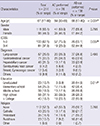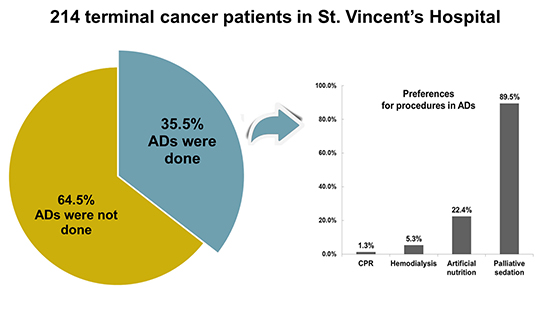1. Brown BA. The history of advance directives: a literature review. J Gerontol Nurs. 2003; 29:4–14.
2. Heo DS. Patient autonomy and advance directives in Korea. J Korean Med Assoc. 2009; 52:865–870.
3. Sun DS, Chun YJ, Lee JH, Gil SH, Shim BY, Lee OK, Jung IS, Kim HK. Recognition of advance directives by advanced cancer patients and medical doctors in hospice care ward. Korean J Hosp Palliat Care. 2009; 12:20–26.
4. Kwon SH, Im SH, Cho KW, Cho E, Yoon SJ, Oh SY. Most advance directives written by patients with advanced cancer or their proxies request only minimally invasive treatments during end-of-life care. Am J Hosp Palliat Care. 2012; 29:622–626.
5. Shim BY, Hong SI, Park JM, Cho HJ, Ok JS, Kim SY, Han SA, Lee OK, Kim HK. DNR (Do-Not-Resuscitate) order for terminal cancer patients at hospice ward in Korea. Korean J Hosp Palliat Care. 2004; 7:232–237.
6. Oh DY, Kim JH, Kim DW, Im SA, Kim TY, Heo DS, Bang YJ, Kim NK. CPR or DNR? End-of-life decision in Korean cancer patients: a single center's experience. Support Care Cancer. 2006; 14:103–108.
7. Kim DY, Lee KE, Nam EM, Lee HR, Lee KW, Kim JH, Lee JS, Lee SN. Do-not-resuscitate orders for terminal patients with cancer in teaching hospitals of Korea. J Palliat Med. 2007; 10:1153–1158.
8. Yoon HM, Choi YS, Hyun JJ. Current situation on signing advance medical directives and actual life-sustaining treatment given at a university hospital. Korean J Hosp Palliat Care. 2011; 14:91–100.
9. Pautex S, Notaridis G, Déramé L, Zulian GB. Preferences of elderly cancer patients in their advance directives. Crit Rev Oncol Hematol. 2010; 74:61–65.
10. Kim SS, Lee WH, Cheon J, Lee JE, Yeo K, Lee J. Preferences for advance directives in Korea. Nurs Res Pract. 2012; 2012:873892.
11. Silveira MJ, Kim SY, Langa KM. Advance directives and outcomes of surrogate decision making before death. N Engl J Med. 2010; 362:1211–1218.
12. Keam B, Yun YH, Heo DS, Park BW, Cho CH, Kim S, Lee DH, Lee SN, Lee ES, Kang JH, et al. The attitudes of Korean cancer patients, family caregivers, oncologists, and members of the general public toward advance directives. Support Care Cancer. 2013; 21:1437–1444.





 PDF
PDF ePub
ePub Citation
Citation Print
Print






 XML Download
XML Download